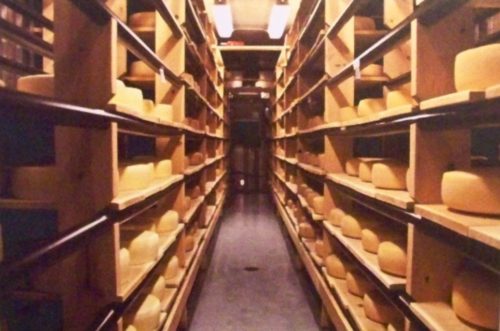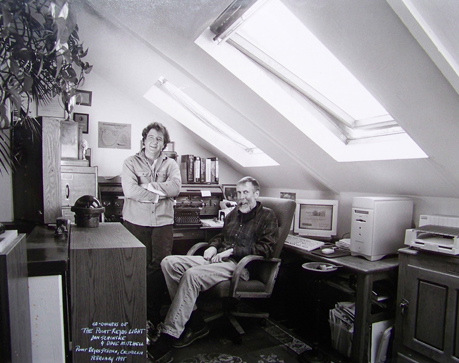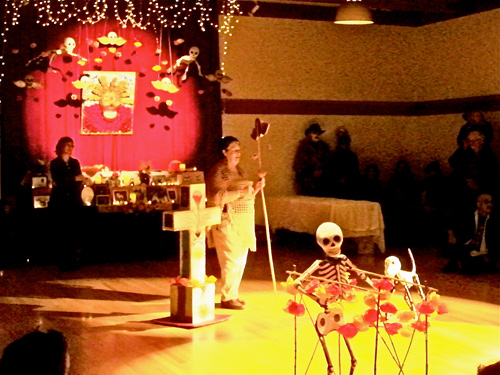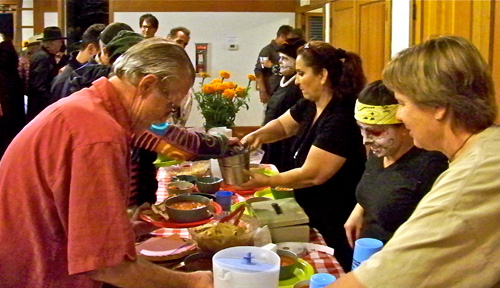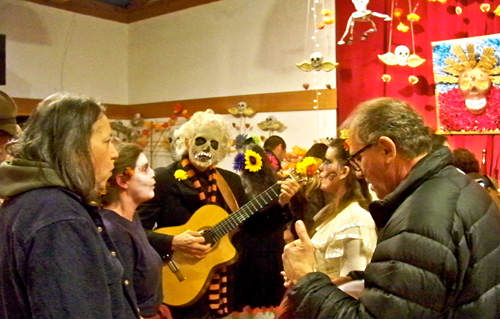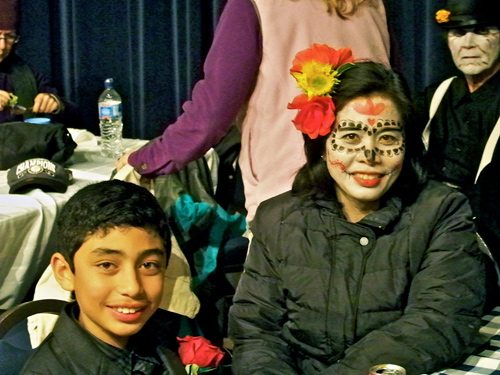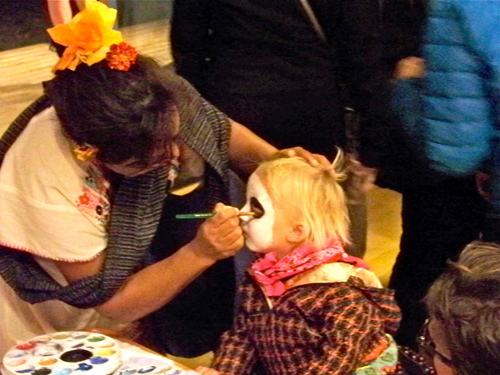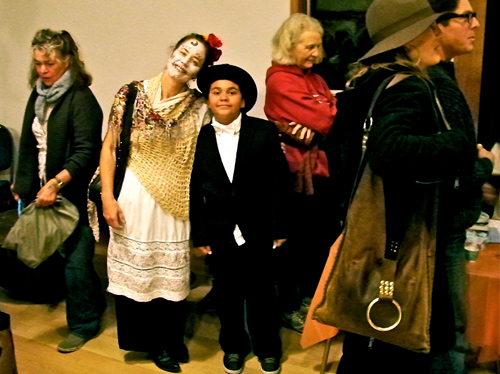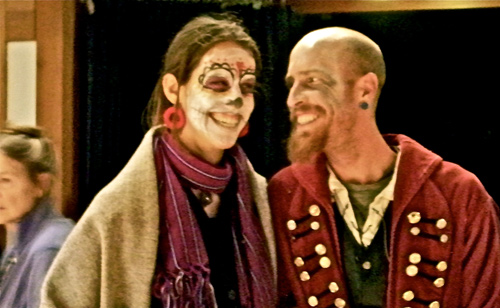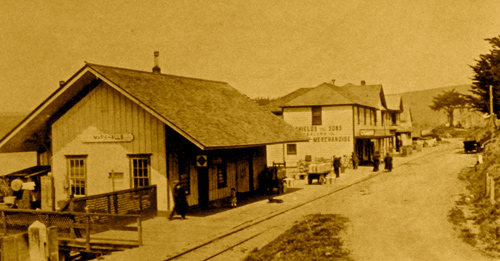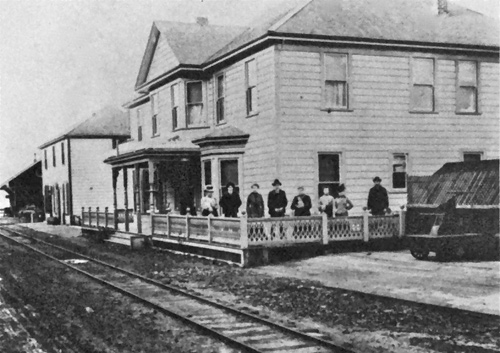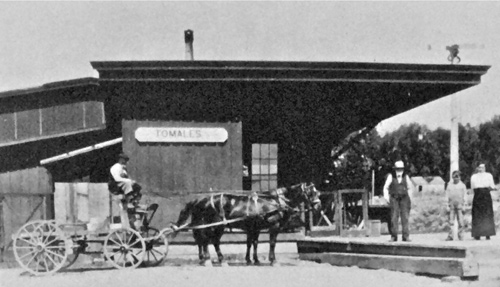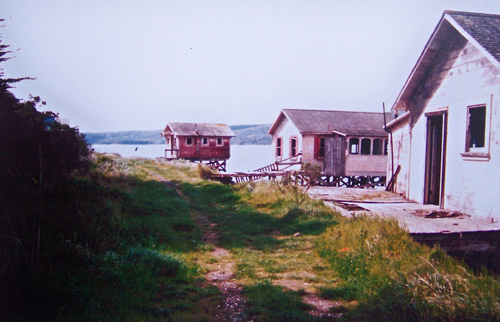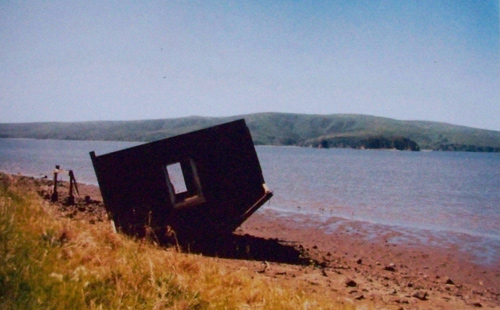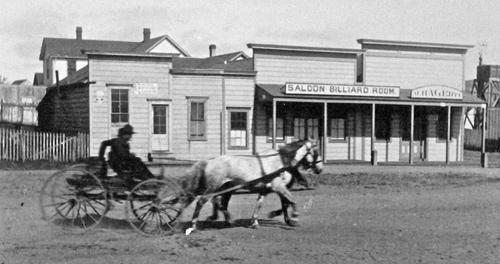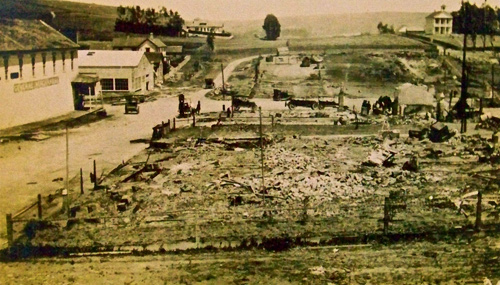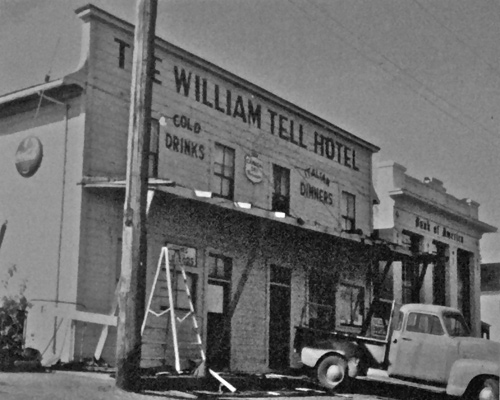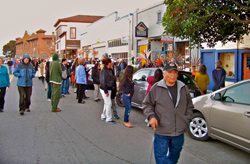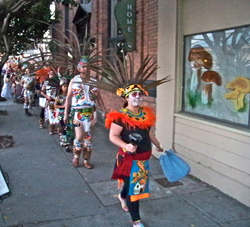Entries tagged with “Tomales Regional History Center”.
Did you find what you wanted?
Mon 14 Nov 2016
Posted by DavidMitchell under agriculture, General News
Comments Off on Milk, cheese, and Donald Trump
Like many of my friends and neighbors, I’m having a hard time coming to terms with the prospect of a Donald Trump presidency; however, I’ll dilute my despondency with joyful pictures from a current exhibit on West Marin’s milk, butter, and cheese industry.
To get our minds off politics for a couple of hours, Lynn and I on Sunday took a drive up the bay to Tomales where the Regional History Center on Saturday and Sunday afternoons is holding an exhibit: “From Milk to Butter & Cheese: 160 Years of Local Creameries.”

The exhibition is in conjunction with one showing through the end of the year at the Bolinas Museum. That exhibit is called, “Bounty: Fine Food Production in Coastal Marin from 1834 to the 21st Century.”
Seen in an historic photo from the Tomales exhibit, a rancher while milking a cow gives a cat a squirt.
Environmentalists I’ve talked with worry about Trump’s financial advisors’ denying climate change, calling for renewed coal mining, and sounding as if they’re willing to sacrifice public land for short-term revenue.
Latino families throughout West Marin are uneasy because many of them have at least one relative who might be deported under Trump’s anti-immigrant proposals.

M.B. Bossevain was Marin County’s first farm advisor. He is seen here in the Tomales exhibit standing in a patch of sweet clover.
Black acquaintances resent Trump’s lack of respect, and they fear he may appoint Supreme Court justices who will overturn major civil rights victories. After all, Steve Bannon, the Breitbart News Network executive chairman who will be Trump’s senior counselor, is known for his white-nationalist views.
The Huffington Post quotes Adam Jentleson, spokesman for Sen. Harry Reid (D-Nev.), as saying Trump’s choice of Bannon “signals that White Supremacists will be represented at the highest levels in Trump’s White House….” It is easy to see why the KKK views Trump as their champion.”
I may not live long enough to see this country recover from the potential damage of a Trump presidency, but sometimes my mortality seems almost consoling. A neighbor, who has resigned himself to one or two terms of Trump, remarked today, “Well, at least I probably won’t live that long.”

In keeping with this melancholy mood, the country this week is simultaneously mourning the death of singer/composer Leonard Cohen. For the last two nights I’ve played his mournful, sometimes hymn-like, music during dinner, which made the meal feel like the Last Supper in a Parisian bistro.
A storage area for the Nicasio Valley Cheese Company (seen in the Tomales exhibition).
Sun 10 May 2015
Posted by DavidMitchell under History
Comments Off on A trip to Tomales
The Light on the Coast: 65 Years of News Big and Small as Reported in The Point Reyes Light, has now sold out virtually all of its third printing. When I wrote the book a year and a half ago with Jacoba Charles as coauthor, I had no idea it would sell so well. Aside from a very few copies at Point Reyes Books, Toby’s Feed Barn, and Tomales Regional History Center, it’s no longer available in West Marin.
The History Center published it, and on Sunday Lynn and I drove to Tomales to drop off the last few copies still on hand. It would have been an easy jaunt were it not for all the bicyclists on Highway 1. Riding four abreast on a two-lane state highway would seem to be the height of either ignorance or arrogance, but at least on this trip we didn’t see any spandex-covered legs sticking out of the ditch.
While in Tomales, Lynn and I stopped at Mostly Natives Nursery to check out the posies, and Lynn found a giant verbena to add to the foliage on our deck. For those of you who aren’t familiar with it, Mostly Natives is a great little nursery right beside Highway 1 downtown. And as it happens, it’s also the setting of one of my favorite stories in The Light on the Coast.
In a March 3, 2005, news article headlined “Wild turkey blacks out Tomales,” Point Reyes Light reporter Peter Jamison wrote: “A surprisingly resilient wild turkey downed power lines in Tomales last week, causing a four-hour blackout. The turkey, by all indications, is still alive and at large.
“Tomales residents Margaret Graham and Walter Earle, owners of Mostly Natives, were drinking tea and reading the paper shortly before 6:45 a.m. last Friday in their home when they were startled by a loud explosion and brilliant flash of light from outside their window.
“Running outside, they discovered three downed power lines and a dazed-looking turkey walking in circles on Highway 1. The couple watched as the turkey ambled into the field across the road from their house, disappearing into the brush.
“‘He could have had a heart attack later on in that field,’ Graham said. ‘But I don’t know. There were some feathers in the road, but they didn’t look burnt.'”
“Earle immediately reported the downed power lines to the Tomales firehouse. ‘Some turkey just took out the power lines,’ he recalled saying. Fire Captain Tom Nunes told The Light that he assumed at the time that Earle was referring to a drunk driver rather than a bird.
“Arriving on the scene, Nunes and a crew of volunteer firefighters were baffled to find a mysterious scattering of feathers, but no turkey. After a search of the area yielded no dead or dying birds, Nunes could only confirm that the turkey had somehow survived a head-on collision with a 12,000-volt power line.
“‘You’d think where the power line broke there’d be a fried bird or something,” Nunes said, ‘but we couldn’t find remnants or anything.’
“The jolt of electricity administered to other birds, such as turkey vultures, that more commonly touch live power lines is so strong that the birds typically burst into flames, Nunes said. Typically this occurs when a vulture sitting on a line starts to take off, and its long wings touch two lines simultaneously. In one such accident in the summer of 1998, a flaming buzzard fell to the ground and ignited a 2.5-acre grass fire along Old Rancheria Road in Nicasio.
“Some 825 households and businesses in Tomales initially lost power when the blackout began at 6:45 a.m. Of these, 622 had their power back on by 8 a.m. All customers had their lights back on by 10:15 a.m., spokesman Lloyd Coker of PG&E said.
“Coker noted that he’s never heard of a bird surviving a brush with power lines, and he could recall only one instance when a wild turkey had flown into a power line, which happened about eight years ago in Sebastopol.
“‘I certainly wouldn’t say it’s a common occurrence,’ he added. The scarcity of such incidents is no surprise since wild turkeys can fly only short distances when they fly at all. ‘They don’t fly all that well, so we’ve had no [previous] cases of turkeys hitting the power lines,’ Nunes said.
“At the site of last week’s mishap, however, a steep hillside serves as a launching pad for the birds, which, frantically flapping their wings, can travel to the field across the road.
“Graham said she and her husband had often witnessed the birds in their short bursts of flight across the highway….”
This excerpt from Jamison’s news story is one example of why I as editor of The Light appreciated his craftsmanship. Nor was I the only editor who did. After he left The Light, Jamison went on to write for SF Weekly, The Tampa Bay Times, and now The Los Angeles Times, where he is the metro reporter.
Meanwhile, back in Tomales, nurseryman Walter Earle today shared his amused memories of that winter day 10 years ago when a wild turkey blacked out the town. In particular, he remembered firefighters preparing for a medical emergency when they thought the “turkey” he was talking about was a drunk driver.
Mon 23 Feb 2015
Posted by DavidMitchell under Point Reyes Station
1 Comment
Just over a year ago, Tomales Regional History Center published my second book (coauthored by Jacoba Charles) The Light on the Coast: 65 Years of News Big and Small as Reported in The Point Reyes Light. The third printing is almost sold out, and it may soon be time for a fourth.
To whet the appetite of those of you who haven’t yet picked up the book, here’s a column from it that was originally written 30 years ago when these ruminations were in print labeled “Sparsely Sage and Timely.” Back then, The Light was published in Point Reyes Station’s Old Creamery Building with the newsroom on the second floor.

The Light’s former newsroom with my partner Don Schinske standing and me sitting at my desk. Back then I wrote and edited text on a computer but wrote headlines on an old-fashioned, standard typewriter and then hand-carried them to the typesetter downstairs. © 1998 Art Rogers/Pt. Reyes, who contributed 10 photos to “The Light on the Coast.”
It’s late in the evening, and I’m sitting at a rolltop desk in the newsroom listening to a dog barking a block or two away. Every minute or so, I can hear a car come down Highway 1 into town and turn the corner by the bank. Once in awhile, a car heads up the hill, probably someone who just stopped in town for a drink before heading home.
When I first arrived in Point Reyes Station in 1975, I slept for a couple of months in the newsroom of the old Light building [across the street from today’s Whale of a Deli]. Despite being at a bend and intersection of a state highway, the spot was reasonably tranquil, at least after midnight. Oh, there’d be a brief flurry of shouting when the bars closed and the sound of unsteady feet scuffing past the window, but for a place to spend the night, a room on Point Reyes Station’s main street wasn’t that bad.
When I was in college and had yet to live in a small town, I chanced to read Winesburg, Ohio, Sherwood Anderson’s sketches of small-town life. In one of the tales, The Teacher, Anderson describes a late evening when there are only three people awake in Winesburg.
Naturally, one of the three was a reporter in the newsroom of the town’s weekly newspaper who pretended to be at work on the writing of a story. At last, the reporter too goes home and to bed. “Then he slept,” wrote Anderson, “and in all Winesburg, he was the last soul on that winter night to go to sleep.”
As a college student used to cities and suburbs, I found the concept of a town where no one was awake so strange that I briefly wondered if such a place were possible. Now, 20 years later, I find myself living in a town where on occasion late at night I probably am the only person downtown who isn’t asleep.
Of course, there are some nights when the tranquility of even this sleeping town is disturbed. A few years ago, Michael Jayson told me at the time, he had been asleep in an apartment over the old Dance Palace [where Cabaline is today] when he was awakened by the thunder of hooves below his window on Third Street.
A dog had gotten into rancher Waldo Giacomini’s pasture [now the Giacomini Wetlands] and began to worry a herd of cows, which then gave chase to the dog, crashing through a barbed-wire fence in their pursuit.
The next morning, Jayson told in amazement of having seen the stampede gallop up Third to Point Reyes Station’s main street and then turn east. At the T-intersection where the main street ends in front of Cheda’s Market, the herd wheeled around and headed back west.
As it happened, a fight had spilled out of the Western Saloon and into the intersection at Second Street where it had caught the eye of a bartender across main street at the Two Ball Inn [now the Station House Café. He called sheriff’s deputies, who had just arrived to break up the brawl when the stampede did it for them.
With a herd of cows galloping toward them, the two brawlers, along with onlookers, scattered. After the stampede had passed, however, the brawlers returned to the intersection only to have the stampede come through again on its second pass.
This time as the crowd dashed for safety, the two combatants kept on running, as did a number of Giacomini’s cows once the stampede reached the west end of main street. It was two days before the rancher got them all rounded up again. “I wish some people would keep their dogs tied up,” he grumbled to me afterward.
Down the street, the dog is barking again,probably bragging about the night when he alone provoked 50 head of Waldo Giacomini’s dairy cows to stampede through the middle of town. April 11, 1985
Mon 3 Nov 2014
The Mexican holiday Dia de los Muertos (Day of the Dead) was observed Saturday evening in downtown Point Reyes Station. It’s a day set aside each year for special remembrances of friends and relatives who have died.
Meanwhile up the bay, Tomales Regional History Center on Sunday opened a well-attended exhibition, “The Region’s Lost Buildings: Their Stories and their Legacies.” More about that in a moment.

A Dia de los Muertos altar in the Dance Palace held dozens of photographs of deceased family members and mementos of their lives.

Saturday’s celebration began with a procession from Gallery Route One to the Dance Palace. These young ladies wore angel costumes and looked very sweet while some celebrants wore Halloween costumes which were downright ghoulish.

Ana Maria Ramirez, the de facto matriarch of the Latino community around Point Reyes Station, spoke in English and Spanish about Dia de los Muertos. The event was organized by Point Reyes Station artist Ernesto Sanchez, who also created the altar. The Dance Palace sponsored the event with financial support from Marin Community Foundation.

A variety of excellent Mexican food drew a long line to the serving table.

Local singer Tim Weed and his partner Debbie Daly (in white) led some impromptu singing in the Dance Palace.

For many in attendance, including Mary Jean Espulgar-Rowe and her son Joshua, it was a family event.

Elvira de Santiago of Marshall paints the face of Ocean Ely, two and a half, of Point Reyes Station.

Carrie Chase and Diego Chavarria, 10, of Point Reyes Station showed up in elegant costumes. Here Diego waits to have his face painted.

And while all this was going on, photographer Eden Trenor (left) of Petaluma and formerly of Point Reyes Station, was having an opening in the Dance Palace lobby for an exhibit of her works. With her is Dan Harrison, a printmaker who owns a gallery in Olema.

This photograph of ponds is part of Trenor’s show, which is called “For the Yes of It.” _______________________________________________________________
“The Region’s Lost Buildings: Their Stories and their Legacies,” which opened at the Tomales Regional History Center Sunday, is also a photographic exhibit for the most part, but the photos are far older.
Curating the exhibition was Ginny Magan of Tomales, and she did an excellent job, both in her choice of pictures to display and in her captions for them.

The narrow-gauge railroad depot in Marshalls, as Marshall used to be called. The Shields store to the right of the depot still survives and now belongs to Hog Island Oyster Company. “This image of Marshall’s depot shows a style typical of small, early train stations across the country, with its board-and-batten siding and deep eaves,” its caption notes.

The Bayview Hotel, which once stood in this spot on the shore of Tomales Bay, was built by the Marshall brothers in 1870 and was frequented by fishermen and hunters.
When it burned in 1896, the Marshall brothers had the North Coast Hotel (above) constructed on the site. “As the photo shows,” the History Center points out, “the building was a few feet from the railroad tracks.
“The hotel was knocked into the bay by the 1906 earthquake, but pulled out and repaired by the owners, Mr. and Mrs. John Shields.
“Except for its use as military housing during the Second World War, the building remained a hotel under several proprietors until it caught fire in 1971. The 25 guests, all the employees, and owner Tom Quinn and his family got out safely, but the hotel, with only its brick chimney standing, was a complete loss.”

“The depot at Tomales was unusual,” according to the History Center’s caption. “Because of its low-pitched roof, it resembles something built a century later. All Tomales railroad buildings were painted a brick red.

The aptly named hamlet of Hamlet, another stop on the North Shore Railway line, was a village from 1870 to 1987, when the National Park Service bought it.
“Hamlet’s namesake was John Hamlet, a dairyman from Tennessee who purchased the site with gold coin in 1870. He left little but his name. The next owner, Warren Dutton, developed Hamlet as a railroad stop that the Marin Journal described as ‘one of the most inviting places on the bay for aquatic sports.’
“To most of today’s locals, the name Hamlet is connected with the Jensen family, who purchased the land in 1907, and developed and inhabited the village over 80 years and four generations. By 1930, the Jensens were establishing Hamlet’s well-known connection with oyster farming.

The Tragedy of Hamlet.
“In 1971, third-generation matriarch Virginia Jensen was left a widow with five children. She, and eventually they, carried on, though maintaining the oyster farm, its retail components, and the property’s buildings was clearly a struggle.
“A 1982 storm all but obliterated the oyster beds. ‘I never planted [oysters] after that; that was my last tally-ho,’ remembered Mrs. Jensen. In 1987, she sold the site to the Park Service, which then looked the other way as vandals and the elements savaged it. In 2003, the Park Service demolished the last of the buildings.

Highway 1 is the main street of Tomales where it’s known as Maine Street.
“Trotting down Maine Street toward First c. 1890. Originally the Union Hotel occupied this site; after it burned this group of small buildings housed a saloon, one of six or eight in the town, a billiard room and Sing Lee Washing and Ironing. Today the Piezzi Building is at this corner.”

“On a windy day in May 1920, the Plank Hotel caught fire. Despite the best efforts of townspeople at least 16 buildings burned to the ground, two dwellings and most of the town’s commercial center south of First Street.”

“The William Tell was established as a hotel and saloon in 1877. The original building burned in the 1920 fire but was rebuilt within the year. This photo was taken in the mid-1950s.

“The Fallon Creamery, built near the end of the 19th century, used state-of-the-art, steam-operated machinery. The creamery exhibited a 500-pound wheel of cheese at the 1894 California Midwinter International Exposition in San Francisco.” ________________________________________________________________
 By the end of the weekend I was again thanking my lucky stars to be living in West Marin. Everybody had been on their good behavior, even the cops.
By the end of the weekend I was again thanking my lucky stars to be living in West Marin. Everybody had been on their good behavior, even the cops.
When a sheriff’s deputy needed to use his patrol car to create a buffer for the DÃa de los Muertos procession marching down Point Reyes Station’s main street, I walked over and with feigned indignation exclaimed, “They’re all jaywalking.” The deputy replied with a laugh, “They are all jaywalking. And everyone is going to get a ticket.” And soon he drove off.
 What a contrast with police in Saint George, Utah. At least according to the Daily Kos website, police last week raided a Halloween party at a family fun center simply because the event included dancing.
What a contrast with police in Saint George, Utah. At least according to the Daily Kos website, police last week raided a Halloween party at a family fun center simply because the event included dancing.
One can only imagine how St. George’s police would have reacted to the Aztec Dancers (left) in Point Reyes Station.
They weren’t just dancing, they were dancing on the main street.
Tags: Aña Maria Ramirez, Dance Palace, DÃa de los Muertos, Debbie Daly, Eden Trenor, Elvira de Santiago, Fallon Creamery, Hamlet, Marshall brothers, Mary Jean Espulgar-Rowe, National Park Service, Tim Weed, Tomales Regional History Center, Virginia Jensen, William Tell Hotel
Tue 11 Feb 2014
Approximately 15 inches of badly needed rain fell in drought-stricken West Marin during the past week, with much of it falling last weekend.
Although the rain flooded numerous roadways, including sections of Highway 1, roughly 50 people showed up at Tomales Regional History Center Sunday to hear Jacoba Charles and me read a few selections from our book, The Light on the Coast: 65 Years of News Big and Small as Reported in The Point Reyes Light.
In December, the History Center published the book, which draws upon news coverage in The Light to tell the post-World War II “history of West Marin’s lively little towns and their Pulitzer Prize-winning weekly newspaper.”
Jacoba and I looked through more than 3,300 back issues in choosing representative selections of writing, photography, and political cartoons to include in the book. We then wrote background narratives for many of the news stories.

The crowd filled the History Center’s conference room, where awards and other mementos from the newspaper’s past were on display. After our readings, Jacoba and I signed copies of the book while directors of the History Center served refreshments. (Photos by Lynn Axelrod)

Jacoba started the readings with Wilma Van Peer’s 1998 account of working for the paper’s founders, Dave and Wilma Rogers, half a century earlier. Mrs. Van Peer described Dave as a “little man” with a “nose for news” who liked to “tease” people.
The Light, which was called The Baywood Press for its first 18 years, has had 10 sets of owners in the past 65 years. I published the paper for 27 of those years and wrote the chapters covering news from the first eight ownerships.
Jacoba reported for The Light during its previous ownership and is on the paper’s board of directors under today’s owner, Marin Media Institute. She compiled the chapters dealing with news coverage under the last two sets of publishers.

I unexpectedly found myself getting choked up while reading aloud an item from a June 22, 1950, column of social news:
“Mr. and Mrs. Anton Kooy and sons Peter, 13 years, and Walter, 11 years, have arrived at Blake’s Landing ranch from Amsterdam, Holland. They have come to join their friends Herbert Angress and Bill Straus, and Anton is going into business with Bill and Herbert. The Kooys will live at the Clark home, which the Harold Johnstones now occupy, near Marshall.
“During the last war, Mr. and Mrs. Kooy took Herbert Angress in to stay with them, thus saving his life from the Nazis. The two boys will be attending the Tomales schools, Peter being of high school age.”
While reading this short item to the crowd, I was once again struck by the horrendous danger in which Herb Angress had found himself and by the Kooy family’s heroism in putting themselves at risk to shelter him. Then, five years after World War II ended, they followed him to West Marin.
What choked me up was the sudden realization that when this potentially tragic drama came to a happy ending in Marshall, it made West Marin seem like part of a wartime miracle.

Jacoba reads the late historian Jack Mason’s account of former publisher Don DeWolfe changing the paper’s name from Baywood Press to Point Reyes Light in 1966. Full of wry humor, the story is set in the Station House Café, which Mason operated for awhile after he retired from an editor’s post at The Oakland Tribune.

Victor Reyes, who writes a Spanish-language column for The Light, filled in for Dewey Livingston during the readings.
The book’s designer, Dewey Livingston, lives in Inverness where he is the historian at the Jack Mason Museum of West Marin History. He had been scheduled to take part in the readings but had to bow out at the last minute. Second Valley Creek behind his house was flooding and undercutting his bedroom, forcing Dewey to stay home and deal with the rising water.
The Light on the Coast reprints the paper’s entire series on the five waves of ethnic immigration to West Marin during the past 160 years. To research the series, the newspaper sent reporters abroad four times in nine years, to Croatia, Northern Ireland and the Irish Republic, Switzerland’s Italian-speaking Canton of Ticino, Portugal’s mid-Atlantic Azores, and the Jalostotitlán region of Mexico.
Victor, who was one of the reporters on the immigration stories from Mexico, described Jalostotitlán and two neighboring towns. Most of West Marin’s Mexican-immigrant families hail from that area.
He stressed how traditional and conservative people are in Jalos (the city’s nickname) although it is only a 90-minute drive from Guadalajara. The priest virtually runs the city, Victor said.
West Marin’s non-Latino residents that are familiar with large Mexican municipalities, such as Mexico City, may think they understand the culture of Mexican-immigrant residents here, Victor said, but Jalos is a world apart, and the difference can sometimes lead to confusion.
Two more readings and book signings are scheduled in West Marin. From 3 to 6 p.m. Saturday, March 1, there will be a reading, a public open house, and a reunion of former Light staff in the newspaper’s new office behind the Inverness Post Office.
Point Reyes Books will sponsor a third reading and book signing at 3 p.m. Sunday, March 9, in Point Reyes Station’s Presbyterian Church.
Sun 8 Dec 2013
The April 12, 1956, edition of Point Reyes Station’s Baywood Press reported: “Mrs. Joe Curtiss’ television set caught fire last week, and the wall behind the set began burning.
“Before the fire department could answer the call, Margie picked up the set, threw it out the window, and proceeded to extinguish the blaze.”
That was the entire report, but Margie must have been a hardy soul because that early TV would have been big and heavy as well as hot.
 The Baywood Press, as The Point Reyes Light was called for its first 18 years, began publication on March 1, 1948.
The Baywood Press, as The Point Reyes Light was called for its first 18 years, began publication on March 1, 1948.
The newspaper’s coverage of the past 65 years of West Marin news, big and small, is the focus of a book its publisher, the Tomales Regional History Center, has just released.
The book’s cover at left.
I’m particularly interested in the book, The Light on the Coast, because I, along with Jacoba Charles, authored it.
The graphic artist was Dewey Livingston, formerly production manager at The Light. He is now the historian at the Jack Mason Museum of West Marin History and is an historian for the National Park Service.
The Light is in its 10th ownership, Marin Media Institute, and the evolution of the newspaper itself is part of the story. As editor and publisher for 27 years, I was responsible for the chapters covering the first eight ownerships. Jacoba, who is on The Light’s board of directors and formerly was a reporter for the paper, was responsible for the most recent two.

Flooding in Bolinas. The ferocious storms that periodically hit the coast have always received extensive coverage in The Light.
Highlights of the 354-page book include the evolution of West Marin agriculture; the effects of the arrival of the counterculture on local politics, law enforcement, and the arts; the creation of the Point Reyes National Seashore and the Golden Gate National Recreation Area.
Examples of The Light’s Pulitzer Prize-winning coverage of violence and other illegal activities by the Synanon cult are, of course, included in The Light on the Coast.
The newspaper’s complete series on the five historic waves of immigration to West Marin is also a central chapter.
The forefathers of many longtime families in West Marin arrived in immigrations from specific locales in: Ireland, Switzerland’s Italian-speaking Canton of Ticino, Croatia, and Portugal’s mid-Atlantic Azores. Researching their journeys to West Marin, as well as the more-recent immigration from Mexico, involved sending Light reporters abroad four times between 1988 and 1997.
 This illustration for Sheriff’s Calls by cartoonist Kathryn LeMieux’s was often used in Western Weekend editions. The final section of our book consists of some of the more unusual Sheriff’s Calls from the the past 38 years.
This illustration for Sheriff’s Calls by cartoonist Kathryn LeMieux’s was often used in Western Weekend editions. The final section of our book consists of some of the more unusual Sheriff’s Calls from the the past 38 years.
The Light on the Coast features, along with a variety of news and commentary, a sampling of cartoons, advertising, and photography (including 10 portraits by Art Rogers). My partner Lynn Axelrod and I reviewed almost 3,000 back issues of The Point Reyes Light/Baywood Press in compiling the book. Jacoba reviewed more than 400. After making our selections, she and I wrote background narratives for many of them.
Those who’ve read the book have had good things to say about this approach of presenting West Marin’s history through the pages of The Light. Commenting on the book, San Francisco Chronicle reporter and columnist Carl Nolte writes: “The Point Reyes Light is a great window into a fabulous small world.”
Dr. Chad Stebbins, executive director of the International Society of Weekly Newspaper Editors, is likewise enthusiastic: “Dave Mitchell and The Point Reyes Light are synonymous with top-shelf newspapering. Dave is one of the few small-town editors ever to win a Pulitzer Prize; his investigation of the Synanon cult is a textbook example of tenacious reporting. His witty and colorful anecdotes always make for good reading.”
The Light on the Coast is available at Point Reyes Books for $24.95 plus tax.
It can be ordered online from the Tomales Regional History Center bookstore for $29.95 including tax and shipping.
Tue 26 Mar 2013
Posted by DavidMitchell under History, Photography
1 Comment
Tomales Regional History Center on Sunday held an opening reception for an engaging exhibition titled “Tomales Neighbors: Informal Portraits by Steve Quirt, Ella Jorgensen, and Others.” The people I spoke with at the opening likewise found the photos fascinating.
 Frances Fairbanks and cat, circa 1920. Frances was the granddaughter of pioneer William Fairbanks, who settled in Tomales in 1864. She was also a niece of Ella Jorgensen. Photo by Ella Jorgensen ___________________________________________________
Frances Fairbanks and cat, circa 1920. Frances was the granddaughter of pioneer William Fairbanks, who settled in Tomales in 1864. She was also a niece of Ella Jorgensen. Photo by Ella Jorgensen ___________________________________________________
Using a box camera, Ella Frisbee Jorgensen around 1900 began shooting photos of townspeople, including Tomales pioneers who by then were already elderly. “In her pantry-turned darkroom, she developed and printed countless photographs,” the spring issue of the Tomales Regional History Center Bulletin notes.
“Photographer Ella Jorgensen spent nearly 50 years chronicling life in the village; much of what we know of early 20th century Tomales is because of Ella’s work.” Jorgensen died in 1945.
Steve Quirt using his iPhone is now shooting similar photos of current townspeople. “Steve’s portraits inevitably recall, not so much in style as in spirit, the casually shot but thoughtfully posed portraits by Ella Jorgensen,” observes the Bulletin.

At the bootery. Carrie Jensen, Jorgen Jensen, Sille Jensen, and Walter Jensen (left to right). Carrie Jensen was a native of Copenhagen who arrived in Tomales in 1857. Photo by Ella Jorgensen _______________________________________________________________

Bakers Charles and Vesta Stone. Photo by Ella Jorgensen. _________________________________________________________________________________________________________________________

/
/
/
/
/
/
/
/
Zilla Ables Dickinson was postmaster in the Tomales Post Office for 35 years. After Zilla and her husband Leon were married in 1886, they bought the general store in Tomales (now Diekmann’s). In 1936, their son Bray took over the business.
Dickinson (above). Photo by Ella Jorgensen.

A. Bray Dickinson. Photographer unknown
Bray Dickinson took over his mother’s position as postmaster in Tomales after she died. He is now best known for his book on the North Pacific Coast Railway, Narrow Gauge to the Redwoods.

Today’s postmaster, Julie Martinoni (right), and Liz Cunninghame of Clark Summit Ranch open a shipment of baby chicks in the Tomales Post Office. Photo by Steve Quirt _______________________________________________________________
 Annette Winn Wilson. Photo by Ella Jorgensen _______________________________________________________________
Annette Winn Wilson. Photo by Ella Jorgensen _______________________________________________________________

Ranchers Loren (left) and Al Poncia. Photo by Steve Quirt _______________________________________________________________
 Bea (McCulla) and V.L. Phillips. Photographer unknown
Bea (McCulla) and V.L. Phillips. Photographer unknown
__________________________________________________________
 Dan Erickson accompanied by his lambs on John Street. Photo by Lisbeth Koelker
Dan Erickson accompanied by his lambs on John Street. Photo by Lisbeth Koelker
________________________________________________________

Edith Bonini, former owner-operator of the William Tell bar. Photographer unknown ________________________________________________________
 Lois Parks and Smokey. Photographer unknown _______________________________________________________________
Lois Parks and Smokey. Photographer unknown _______________________________________________________________

Three girls on Main Street, May 1917. Mercie Wilson at far right with two unidentified girls. Photo by Ella Jorgensen _______________________________________________________________

George Dillon (left) and Thomas Ables. Photo by Ella Jorgensen
Dillon, a native of Ireland, crossed the Great Plains in 1856. In the 1860s, he bought a 644-acre ranch at the mouth of Tomales Bay and “threw his beach open to his friends,” according to the late historian Jack Mason. “In 1888, as near as can be determined, [he] built an 11-bedroom hotel.” The building “is still there,” Mason wrote in Earthquake Bay (published 1976). When Dillon in his later years sold the property in 1903, he stipulated that the area would forever be called Dillon Beach.
Thomas Ables (standing with Dillon) was a bank cashier who went on to become the Marin County Superintendent of Schools. _______________________________________________________________

Norman Meyers (left) and Fred Jorgensen. Photo by Ella Jorgensen _______________________________________________________________
 Hazel Guldager (Martinelli). Photo by Ella Jorgensen ____________________________________________________________
Hazel Guldager (Martinelli). Photo by Ella Jorgensen ____________________________________________________________
When the History Center’s curator, Ginny MacKenzie Magan, wrote an announcement of last Sunday’s opening for The West Marin Citizen, she noted it would be a 50-photo exhibition of Tomales neighbors over the past 150 years.
“These people, along with many others, have contributed some subtle essence of their character to the town,” she explained. “For over a century and a half, a few hundred at a time, neighbors have participated in this mysterious alchemy, contributing their intellects and their emotions, their talents and their eccentricities, coloring this place and adding to the ever-changing essence that is this small assortment of humanity….
“The exhibit celebrates these neighbors, those among us today, those we remember, and those we never knew.”
Tags: A. Bray Dickinson, Al Poncia, Bea Phillips, Dan Erickson, Dillon Beach, Edith Bonini, Frances Fairbanks, George Dillon, Ginny Magan, Hazel Guldager, Hazel Martinelli, Julie Martinoni, Leon Dickinson, Liz Cunninghame, Lois Parks, Loren Poncia, Thomas Ables, Tomales, Tomales Regional History Center, V.L. Phillips, William Fairbanks, Zilla Ables Dickinson
Mon 6 Aug 2012
Posted by DavidMitchell under General News, History
1 Comment
“Tomales Union High School opened on Aug. 5, 1912, with 23 students and one teacher/principal,” notes a Tomales Regional History Center Bulletin. On Sunday, Aug. 5, the museum opened an exhibit celebrating the school’s last century.
Approximately 300 people, including many former students, packed the history center, which is located in the high school’s former gym in downtown Tomales. The crowd at times was so thick that just getting around in the history center required a litany of “excuse me, excuse me, excuse me.”

The original Tomales High schoolhouse.

The class of 1916 was the first to complete four years at the high school. Teacher Edith Wilkins is at left and principal Benjamin Pratt is at right. Between them are (from left) students Marie Dempsey, Elsie Basset, Truman Fairbanks, Jane Burns, and Vivian Swanson.

Before the two-classroom school was a decade old, it was expanded to 10 classrooms thanks to a $30,000 school bond. “A hyphen-like hallway,” in the words of the history center, connected the new classrooms with the original school.

“The boys locker room in the school’s basement was one of the amenities of the larger school,” notes the history center.

Tomales High’s first school bus was chain-driven. Standing outside the bus is student and driver Harold Maloney, class of 1919. Original photo by Ella Jorgensen.

Tomales High’s third school bus as seen in the 1930s.

Attending Sunday’s opening of the exhibit was May Velloza of Point Reyes, a 1946 graduate of Tomales High and a school bus driver for almost eight years in the 1970s. How did students on the bus behave back then? “I had really good kids,” she replied. “You know why? ‘Cause I knew the parents.”

Tomales High’s first agricultural teacher, William Reasoner, started the Tomales chapter of Future Farmers of America in 1929. Here is Reasoner with his National Champion dairy-cow judging team in 1931. From left: Reasoner, Neibo Casini, Donato Albini, Donovan Rego, and Ed Williams.

The National Championship trophy.

During Sunday’s opening of the history center exhibit, guests could also get tours of the new high school to see recent construction there.
The California Field Act mandates that all the state’s public schools be earthquake safe, and Shoreline School District trustees in the 1960s were faced with either retrofitting the old school or building a new one.
“Bond elections to finance various options followed and were twice narrowly defeated,” the history center bulletin notes. “One vocal group of residents believed the school should be abandoned altogether and its students dispersed to other, larger schools. Thus the question of Small-local-school versus Larger-more-specialized-school insinuated itself into the referendum process, its echo reverberating to this day.
“Finally in 1967 a third election was successful. Affirmative votes in all precincts except Inverness resulted in an overall 73 percent approval for the $1.1 million bond to finance a new high school. In a busy two years, a piece of property just east of Tomales was purchased from Romero Cerini; architects and contractors were consulted. The trustees worked hard to educate themselves about modern high school design.”
In 1969, the new high school opened along the Tomales-Petaluma Road.

Remnants of the old school. After the new high school opened, the old campus was largely unused, and in November 1977, most of the old school burned in a fire that many people suspected was arson although that was never established.
Left undamaged by the fire was the school’s gym, and in 1998 the building was restored to become the Tomales Regional History Center where the school exhibit is now on display.

Tomales High’s sports teams have done well over the years. The girls volleyball team won its division in 1998.
During World War II, Tomales High sports were limited to intramural games. The history center bulletin explains why:
“Student Kathie Nuckols (Lawson) clearly remembered the Monday morning of Dec. 8, 1941, little more than 24 hours after Pearl Harbor was bombed. ‘Our principal called all the students… into the auditorium to hear President Roosevelt call our country to war. His voice came through a small radio, and we strained to hear his words, overwhelmed by the drama as only teenagers can be.’
“Blackout shades lowered in the auditorium, tanks passing the school on their way to occupy Dillon Beach, the imposed limits on travel because of gas rationing, especially affecting the sports programs which were, for the duration, limited to intramural games. These are some of the things students of the war years remembered.
“Yet these events were undoubtedly put into perspective by the biggest effect of all, the nine Tomales High students who did not come home from the war.”

The 1946 Tomales High band.

The 1954 band performs at a football game.

The Tomales High band in 1973. The school didn’t hold a nighttime football game until 2004.

Tomales High teams were originally called the Wolves, but in 1950, the name was changed to the Braves. Originally the mascot was symbolized by a cartoon-like Indian, but that image was later changed to the one here. In 2001, Shoreline School District trustees decided the name was disrespectful to Native Americans and voted to change it.
However, many district residents objected, including several Miwok descendants who said the name had been changed to Braves to honor them. A petition signed by 90 percent of the student-body objected to the change, and more than 100 of the school’s approximately 175 students cut class for half a day in protest.
Eventually the trustees voted to keep the name Braves but to drop the Indian image, saying it looked like a Great Plains Indian, not a Miwok.

Sports, agriculture, and sewage. Cows peacefully graze beside the town sewage ponds Sunday afternoon. The bleachers of Tomales High’s ballfield are in the background.
The tranquility of this scene was in sharp contrast to the high-spirited crowd at the history center. The biggest contrast of all, however, occurred a few hours later.

NASA illustration of Curiosity on Mars.
About 10:30 p.m. local time, a global audience went into a frenzy of excitement as NASA scientists endured what they called “seven minutes of terror” and gently landed a sizable exploratory-robot called Curiosity on the planet Mars 154 million miles away. What an historic day!


